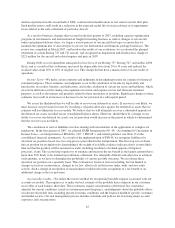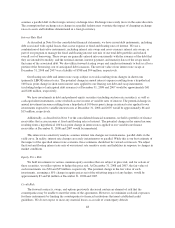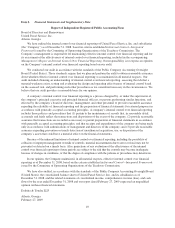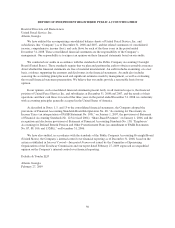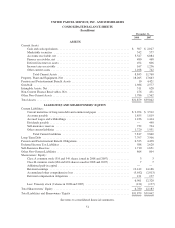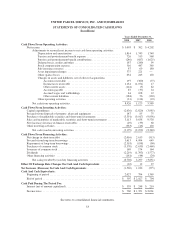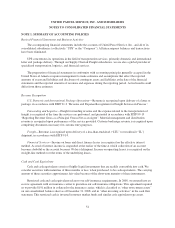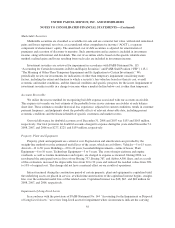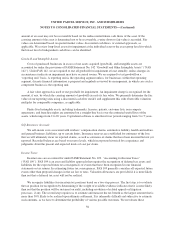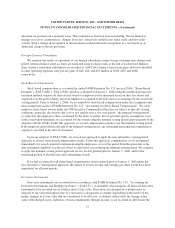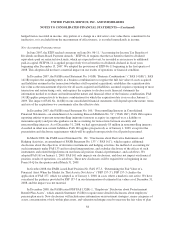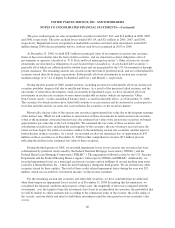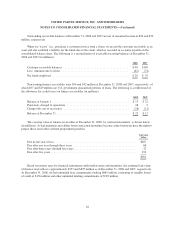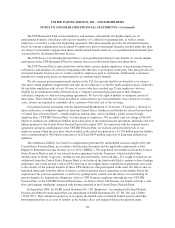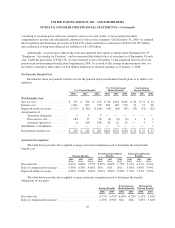UPS 2008 Annual Report Download - page 66
Download and view the complete annual report
Please find page 66 of the 2008 UPS annual report below. You can navigate through the pages in the report by either clicking on the pages listed below, or by using the keyword search tool below to find specific information within the annual report.UNITED PARCEL SERVICE, INC. AND SUBSIDIARIES
NOTES TO CONSOLIDATED FINANCIAL STATEMENTS—(Continued)
Marketable Securities
Marketable securities are classified as available-for-sale and are carried at fair value, with related unrealized
gains and losses reported, net of tax, as accumulated other comprehensive income (“AOCI”), a separate
component of shareowners’ equity. The amortized cost of debt securities is adjusted for amortization of
premiums and accretion of discounts to maturity. Such amortization and accretion is included in investment
income, along with interest and dividends. The cost of securities sold is based on the specific identification
method; realized gains and losses resulting from such sales are included in investment income.
Investment securities are reviewed for impairment in accordance with FASB Statement No. 115
“Accounting for Certain Investments in Debt and Equity Securities” and FASB Staff Position (“FSP”) 115-1
“The Meaning of Other-Than-Temporary Impairment and Its Application to Certain Investments.” We
periodically review our investments for indications of other than temporary impairment considering many
factors, including the extent and duration to which a security’s fair value has been less than its cost, overall
economic and market conditions, and the financial condition and specific prospects for the issuer. Impairment of
investment securities results in a charge to income when a market decline below cost is other than temporary.
Accounts Receivable
We utilize the reserve method for recognizing bad debt expense associated with our accounts receivable.
This requires us to make our best estimate of the probable losses in our customer receivables at each balance
sheet date. These estimates consider historical loss experience, adjusted for current conditions, trends in customer
payment frequency, and judgments about the probable effects of relevant observable data, including present
economic conditions and the financial health of specific customers and market sectors.
Our total allowance for doubtful accounts as of December 31, 2008 and 2007 was $155 and $163 million,
respectively. Our total provision for doubtful accounts charged to expense during the years ended December 31,
2008, 2007, and 2006 was $277, $225, and $159 million, respectively.
Property, Plant and Equipment
Property, plant and equipment are carried at cost. Depreciation and amortization are provided by the
straight-line method over the estimated useful lives of the assets, which are as follows: Vehicles—5 to 15 years;
Aircraft—12 to 30 years; Buildings—20 to 40 years; Leasehold Improvements—terms of leases; Plant
Equipment—6 to 10 years; Technology Equipment—3 to 5 years. The costs of major airframe and engine
overhauls, as well as routine maintenance and repairs, are charged to expense as incurred. During 2006, we
reevaluated the anticipated service lives of our Boeing 757, Boeing 767, and Airbus A300 fleets, and as a result
of this evaluation, increased the depreciable lives from 20 to 30 years and reduced the residual values from 30%
to 10% of original cost. This change did not have a material effect on our results of operations.
Interest incurred during the construction period of certain property, plant and equipment is capitalized until
the underlying assets are placed in service, at which time amortization of the capitalized interest begins, straight-
line, over the estimated useful lives of the related assets. Capitalized interest was $48, $67, and $48 million for
2008, 2007, and 2006, respectively.
Impairment of Long-Lived Assets
In accordance with the provisions of FASB Statement No. 144 “Accounting for the Impairment or Disposal
of Long-Lived Assets,” we review long-lived assets for impairment when circumstances indicate the carrying
55


